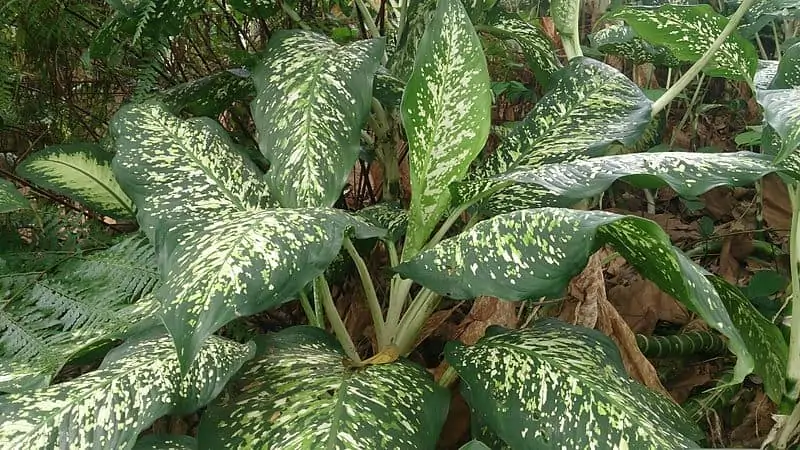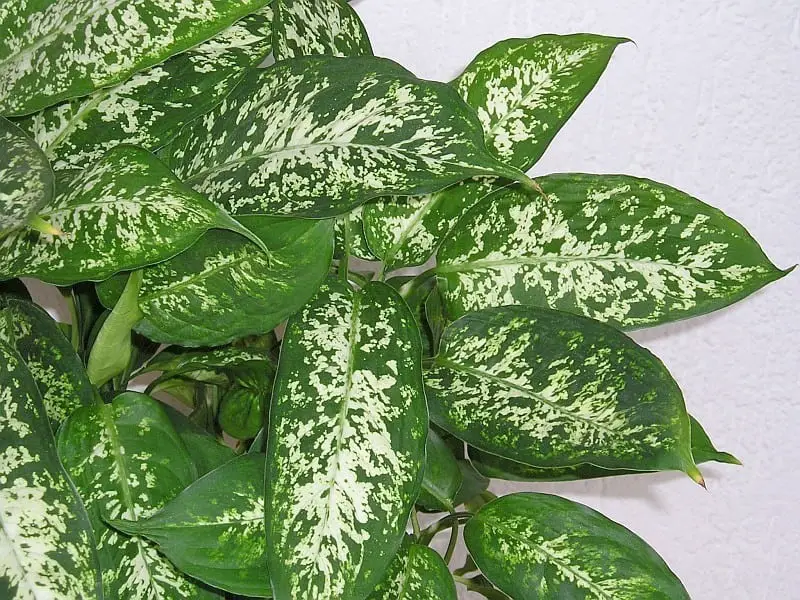This post contains affiliate links. If you buy something from one of our links we may earn a commission. Thanks

Dieffenbachia is a popular houseplant that is known for its lush, green leaves.
Dieffenbachias are easy to care for, but there are a few things you should know in order to keep them healthy and looking their best.
Dieffenbachia Care Key Takeaways:
- Dieffenbachia care involves watering when the soil starts to dry at the top, fertilizing monthly during the growing season, and providing bright, indirect light.
- It’s essential to keep them in warm temperatures, ideally 18-24°C, and avoid cold drafts.
- Pruning for shape and propagating from stem cuttings are also common practices to maintain a healthy, lush Dieffenbachia plant.
In this Dieffenbachia care guide, we will discuss the best way to care for your Dieffenbachia plants.
We will cover everything from watering to fertilizing to pruning.
So if you want to learn how to take care of your Dieffenbachia plants, read on!
1. Dieffenbachia Overview
Dieffenbachia, also known as Dumb Cane, is a tropical plant that is native to the Americas.
Dieffenbachia is a popular houseplant because it is easy to care for and can tolerate low light conditions.
Dieffenbachia gets its common name, Dumb Cane, from the fact that the sap of the plant can cause temporary paralysis of the tongue if ingested. Dieffenbachia – Wikipedia
Dieffenbachia is a member of the Araceae family, which also includes Philodendron and Peace Lilies.
Dieffenbachia plants can grow to be several feet tall and have large, elliptical leaves.
The leaves are often variegated with shades of green, yellow, and white.
Dieffenbachia is a relatively low-maintenance plant, but it does require some basic care in order to thrive.
Dieffenbachia should be watered regularly and fertilized every few months.
The plant will also benefit from being placed in a humid environment. Dieffenbachia makes an excellent houseplant for beginners and experienced gardeners alike.

2. How to water a Dieffenbachia
While Dumb Cane is relatively easy to care for, it does require some attention to watering.
Dieffenbachia should be kept in moist, but not soggy, soils. Allow the top few inches of soil to dry out between watering.
Dieffenbachia also enjoys high humidity levels, so it is a good idea to mist the leaves regularly or set the plant on a pebble tray filled with water.
Dieffenbachia is not tolerant of cold temperatures, so it is important to protect it from drafts and keep it out of reach of small children and pets who might accidentally knock it over.
3. Fertilizing a Dieffenbachia
Dieffenbachias, also known as Dumb Canes, are popular houseplants that are known for their striking foliage.
The leaves of Dieffenbachias are typically large and variegated, and they can add a touch of tropical elegance to any room.
While Dieffenbachias are relatively easy to care for, they do require some basic maintenance in order to stay healthy.
One important task is fertilizing. Dieffenbachias should be fertilized every two weeks during the growing season, and every month during the winter.
When fertilizing Dieffenbachias, it’s important to use a balanced fertilizer that is specifically designed for houseplants.
This will help to ensure that your Dieffenbachia gets the nutrients it needs without being over-fertilized.
With a little care, your Dieffenbachia will thrive and provide you with years of beauty.
4. Pruning a Dieffenbachia
While Dieffenbachia is relatively easy to care for, it does require occasional pruning to keep it looking its best.
When pruning Dieffenbachia, it is important to use sharp, clean scissors or shears.
Make sure to remove any yellow or brown leaves, as well as any stems that are longer than you would like.
You can also trim back the plant to encourage new growth.
Dieffenbachia is relatively tolerant of pruning, so don’t be afraid to it cut back but don’t go crazy.
If the plant is really overgrown it is best to prune in stages and don’t try to take everything off at once.
Cutting this plant back will help make it grow new branches and it will become bushier.
5. Dieffenbachia Propagation
Dieffenbachia, also known as Dumb Cane, is a popular houseplant that is relatively easy to propagate.
One of the most common methods of propagation is to take stem cuttings.
To do this, simply cut a healthy stem from the plant, making sure to include several nodes as well as several leaves.
Next, remove the lower leaves from the stem and dip the cut end in rooting hormone.
Finally, plant the stem in a pot filled with moistened potting mix and place it in a warm location.
With proper care, in several weeks the cutting should root and will soon produce new growth.
Dieffenbachia propagation from stem cuttings is a simple way to create new plants.
It is a great way to fill your home with these beautiful foliage plants. They also make great gifts.
6. Dieffenbachia pests and diseases
Dieffenbachia, also known as Dumb Cane, is a tropical plant that is often grown indoors.
It is known for its large, glossy leaves and its ability to tolerate low light conditions.
Dieffenbachia is generally a trouble-free plant and seldom has any problems.
However, Dieffenbachia can be susceptible to pests and diseases. Common problems include aphids, mealybugs, spider mites, and root rot.
If you don’t overwater and use a well-draining grow medium you can avoid getting root rot.
But bugs may find your Dumb Cane even with the best of care but they rarely damage healthy plants.
Dieffenbachia plants that are stressed or unhealthy are more likely to experience problems with pests and diseases.
Therefore, it is important to provide proper care for Dieffenbachia plants in order to keep them healthy and pest-free.
Dieffenbachia plants that are well-cared-for will thrive and provide years of indoor beauty.
7. Dieffenbachia Potting And Soil
Dieffenbachia, also known as Dumb Cane, is a popular houseplant that is easy to care for but will eventually outgrow its pot.
When potting or repotting Dieffenbachia, it is important to use a well-draining potting mix.
This can be accomplished by adding some perlite to a standard potting soil.
Coco coir is another excellent fast-draining potting medium and can be used with or without perlite.
The trick to using coco is to feed it. Many potting mixes contain added nutrients but coco coir is an inert medium and needs to be fertilized.
Dieffenbachia prefers to be slightly pot-bound, so choose a pot that is only slightly larger than the current one.
Water your Dieffenbachia after potting it up and then water when the top inch of soil is dry.
Allow the water to drain fully before putting the plant back in its saucer.
8. Dieffenbachia Is Poisonous
Dieffenbachia, also known as Dumb Cane, is a popular houseplant that is easy to care for and has attractive, variegated leaves.
However, despite the attractiveness of Dieffenbachia is poisonous to dogs, cats, and humans if ingested.
Symptoms may include:
- Blisters in the mouth
- Burning in mouth and throat
- Diarrhea
- Hoarse voice
- Increased saliva production
- Nausea and vomiting
- Pain on swallowing
- Redness, swelling, pain, and burning of the eyes, and possible corneal damage
- Swelling of mouth and tongue
Dieffenbachia poisoning Information | Mount Sinai – New York
Dieffenbachia is especially dangerous to children and pets, who may be tempted to nibble on its leaves.
If you suspect that someone has eaten Dieffenbachia, it is important to seek medical attention immediately.
While Dieffenbachia makes a beautiful addition to any home, it is important to keep it out of reach of children and pets.
Dieffenbachia Care FAQs
Indoor gardening enthusiasts often find themselves charmed by the lush foliage of the Dieffenbachia plant.
However, to keep this green companion thriving, it’s essential to arm oneself with the right information.
Below are some common queries regarding Dieffenbachia care, aimed to provide a quick yet thorough understanding of nurturing this houseplant.
Q. Why are the leaves on my Dieffenbachia turning yellow?
A. It’s normal for the bottom leaves to turn yellow and eventually drop off due to the plant’s growth pattern.
However, if multiple leaves are yellowing simultaneously or aren’t the bottom leaves, there could be underlying issues such as over or under-watering, or pest infestations.
Q. Why is my Dieffenbachia drooping?
A. Dieffenbachia may droop due to over or under-watering, exposure to hot or cold drafty air, houseplant bugs, or transplant shock.
It’s crucial to maintain a consistent watering schedule and protect the plant from extreme temperature fluctuations.
Q. How often should I water my Dieffenbachia plant?
A. Instead of a fixed schedule, check the soil every few weeks by inserting your finger about 1″ into the soil.
Water the plant when the soil feels dry at this depth. This method ensures that the plant receives water when needed, promoting healthier growth.
Q. Can you cut back a Dieffenbachia?
A. Yes, pruning is part of regular Dieffenbachia care. Cutting back helps in encouraging new leaf growth below the cut. Moreover, the cuttings obtained from pruning can be rooted to create new plants, making this practice both a maintenance and propagation technique.
These Q and A’s offer a window into the fundamental care regime for Dieffenbachia. Armed with this knowledge, nurturing a Dieffenbachia to full leafy splendor becomes a much more achievable endeavor.
Dieffenbachia Care Guide Final Thoughts
Dieffenbachia is a beautiful houseplant that can add a touch of tropical elegance to any room.
While Dieffenbachia is relatively easy to care for, it does require some basic maintenance in order to stay healthy.
Following the tips in this Dieffenbachia care guide will help you be successful in keeping your Dumb Cane happy and healthy.
This includes fertilizing every two weeks during the growing season and monthly during the winter, as well as occasional pruning.
Dieffenbachias are also relatively easy to propagate from stem cuttings.
However, just like any plant, they can be susceptible to pests and diseases.
Therefore, it is important to provide proper care for Dieffenbachia plants in order to keep them healthy and pest-free.
With a little bit of care, your Dieffenbachia will thrive and provide you with years of enjoyment.






